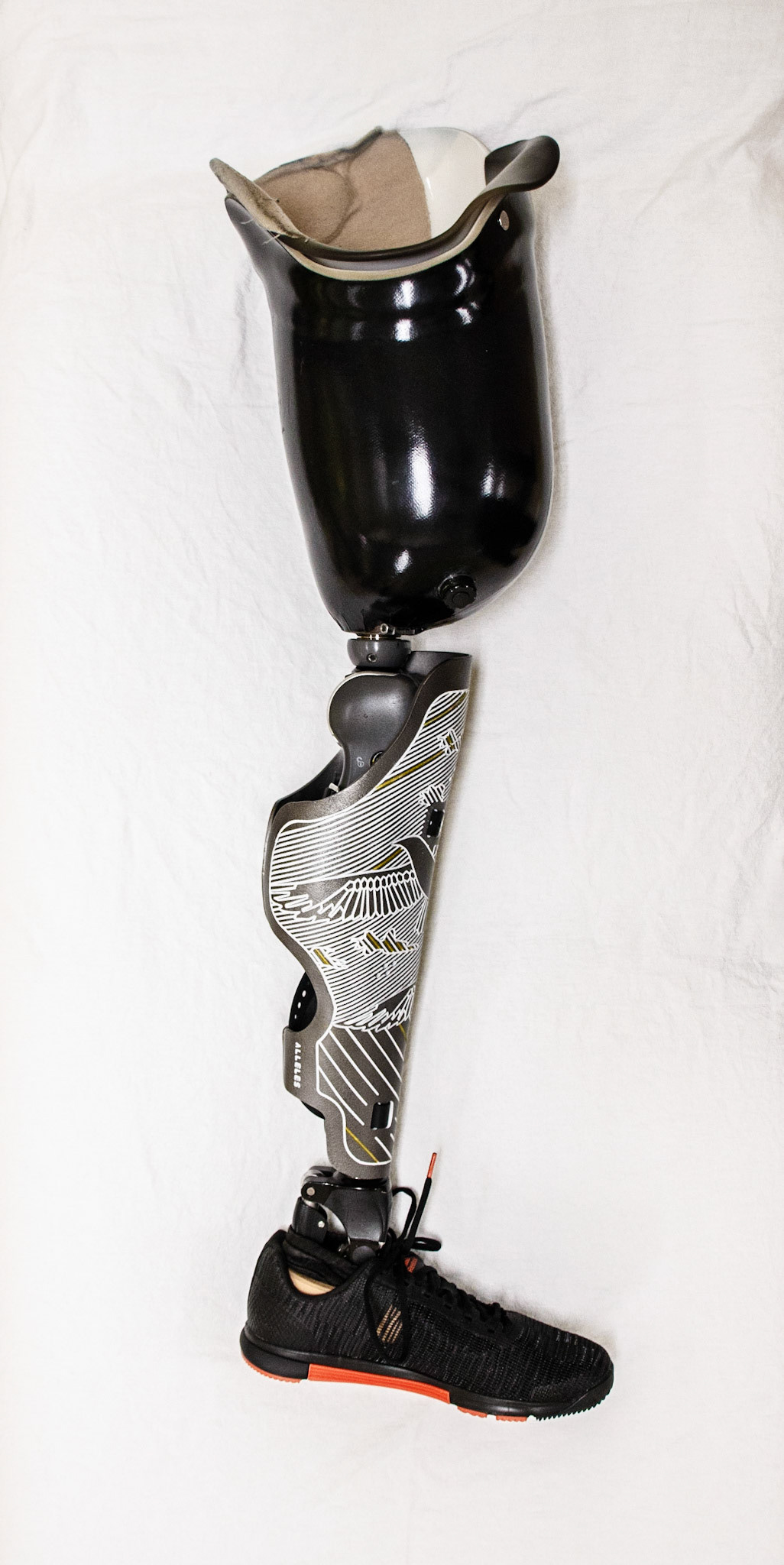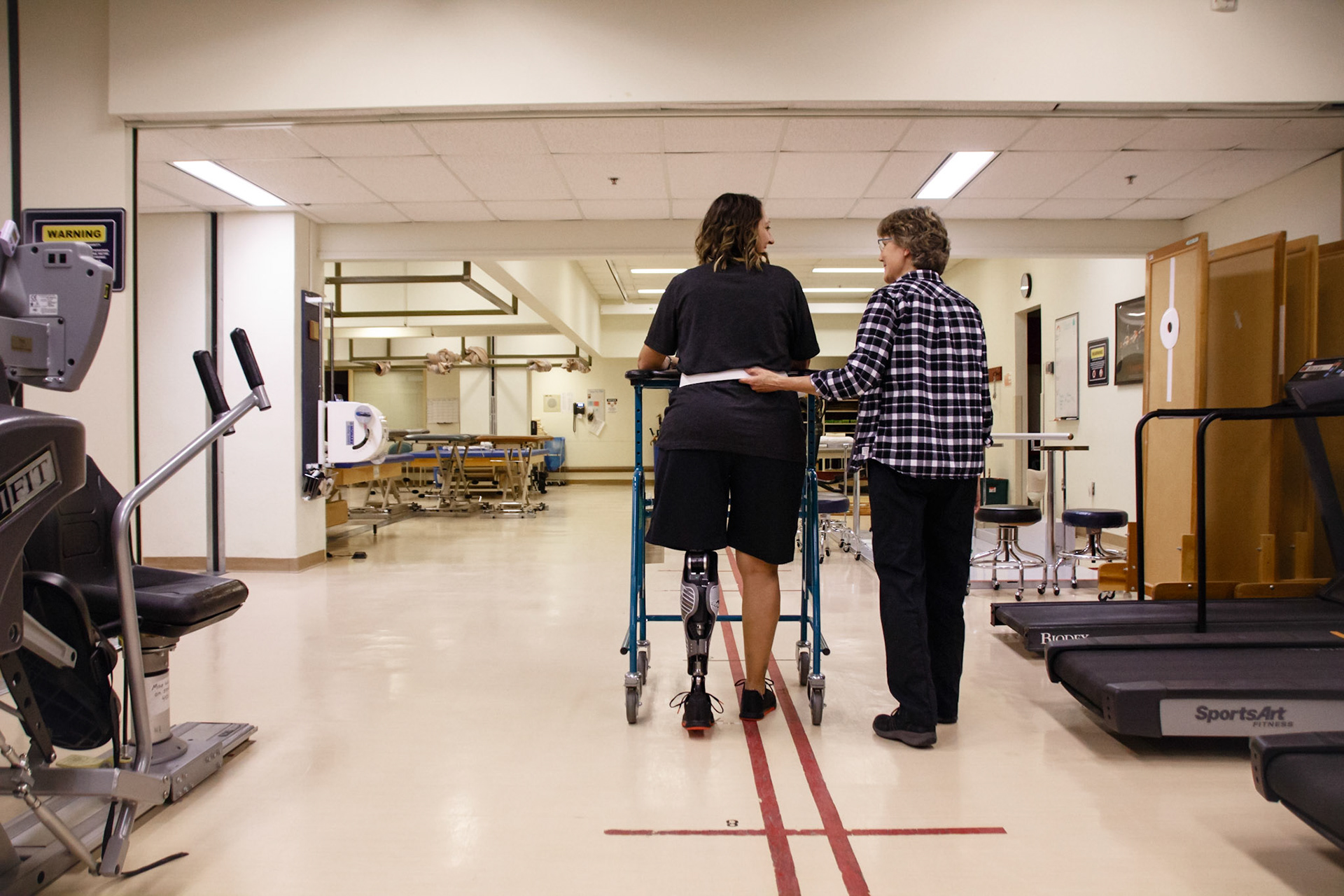
Jaki Biesenthal prepares to reattach her prosthesis while going through the motions of a physiotherapy appointment at Regina's Wascana Rehabilitation Centre on March 15, 2019. Jaki must attach the 14-pound prosthetic leg each time she wakes up in the morning to simply stand up and walk. In her words, "It's like travelling with a baby."

Jaki Biesenthal holds a photo of herself on a motorcycle before the 2014 crash that resulted in her left leg being amputated. While on a ride with several members of the motorcycling community in Regina, Jaki was hit by a car when its driver suffered a sudden cardiac arrest. The driver did not survive. Jaki spent a month at the Regina General Hospital and two months living at Wascana Rehabilitation Centre, after which she continued attending physiotherapy sessions as an out-patient.


A prosthetist at Regina's Wascana Rehabilitation Centre shapes a prosethic leg according to measurements that he has marked in blue on April 2, 2019. Prior to this stage, a casting is done on the patient's "stump," or "residual leg," so that a socket can be custom-built to their fit. The result is a hollow cast which is then filled with plaster of Paris and subsequently marked up and perfected by a prosthetist based on the cast itself and a series of careful measurements. A technician will then recieve the prosthesis in time to create the plastic outer shell, which becomes the actual socket, before testing begins with a patient.


Discarded casts lie under a counter at Regina's Wascana Rehabilitation Centre, marked with patient's initials. Prosthetists always go through several iterations of the same prosthesis with each patient. The size of the human leg changes over time as swelling goes down and the leg muscles atrophy around an injury. Amputation is a lifelong process of change that involves regular new prosthetics and much trial and error. The Saskatchewan government covers all costs associated with basic prosthetic legs.

A prosthetist at Regina's Wascana Rehabilitation Centre prepares a prosthetic leg for a young girl.

A prosthetist at Regina's Wascana Rehabilitation Centre displays a series of colours and patterns with which patients can choose to decorate the exterior shell of their prosthesis.

A shoe rests on the custom orthotic shoemaker's work bench at Regina's Wascana Rehabilitation Centre. Patients have a great degree of freedom in customizing both the outer shell of their prosthesis and the shoes to be attached to them. The Centre's shoemaker is retiring at the end of the month, meaning that production of orthotic shoes will be relocated to a factory in China. Shoes will still be made specifically for each prosthetic, but with far fewer options for customization.

Prosthetic legs from 1946 (second from the left, standing) to today, stand in the physiotherapy department of Regina's Wascana Rehabilitation Centre. On the right stand two prosthetic legs, which would be used by a bilateral amputee. These examples are used for training, and in some cases, to refer to if patients using similar models need repairs.

Jaki Biesenthal's prosthetic leg is a Rheo 3 model. It contains a microprossor that senses where her weight is placed during each stride and continually adjusts a locking mechanism in the knee through her walking cycle. While the Saskatchewan government pays for basic prosthetic limbs, SGI paid for this $30,000 model because the injury was sustained in a motor vehicle accident.

Jaki Biesenthal observes her posture in a mirror during an appointment at Wascana Rehabilitation Centre with physiotherapist Barbara Anderson on March 15, 2019. The initial trial and fitting process begins with patients standing using the support of fixed parallel bars. Mirrors are regularly used to give patients visual feedback during appointments.

Jaki Biesenthal practices walking alongside physiotherapist Barbara Anderson during appointment at Wascana Rehabilitation Centre on March 15, 2019. At this stage, Jaki is learning to walk with her new prosthetic leg with the support of a walker and a physiotherapist.

Jaki Biesenthal demonstrates an exercise at an appointment at Wascana Rehabilitation Centre with physiotherapist Barbara Anderson on March 15, 2019. At this stage, Jaki is being taught how to climb stairs, supported by a physiotherapist. On stairs, new patients often want to lead with their prosthetic leg, but this is impossible for patients with above the knee amputations, as they lack the knee joint and muscle control necessary to pull themselves up.

Jaki Biesenthal rests her hands in her lap at Regina's Wascana Rehabilitation Centre on March 15, 2019.

After several months of physiotherapy, Jaki Biesenthal leaves an appointment at Regina's Wascana Rehabilitation Centre with physiotherapist Barbara Anderson on March 15, 2019. Jaki's ability to walk independently is, according to Barbara, "a huge accomplishment that Jaki worked extremely hard to achieve."

Jaki sits on her Can-Am Spyder in her garage in Regina on April 2, 2019. Using a model that allows her to shift gears with her hand instead of her left foot, Jaki is able to continue riding.































